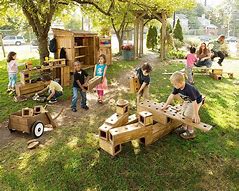In the realm of early childhood education, the environment holds an unparalleled potential to shape the learning experiences of young children. Beyond the guidance of educators and the interaction with peers, the environment acts as a “third teacher,” a concept rooted in the philosophy that spaces can significantly influence development and learning. This post delves into how early educators and advocates for play-based experiences can harness the environment to enrich children’s learning journeys.
The Power of Thoughtfully Designed Spaces
A thoughtfully designed learning environment offers more than just safety and accessibility; it is imbued with the potential to inspire curiosity, foster engagement, and facilitate meaningful discoveries. Such an environment is characterized by its responsiveness to the children’s interests, needs, and developmental stages. It provides a variety of materials and setups that invite exploration, experimentation, and play.
Elements of a Learning-Enriched Environment
Nature and Outdoor Spaces: Incorporating elements of nature into the learning environment encourages children to explore the natural world, develop respect for living things, and understand environmental stewardship. Outdoor spaces offer endless possibilities for physical play, sensory experiences, and scientific inquiry.

Flexible and Adaptable Areas: Spaces that can be easily rearranged or adapted allow for the environment to reflect the changing interests and developmental needs of children. Flexible seating, movable dividers, and multipurpose materials support a range of activities, from quiet reading nooks to bustling construction zones. Flexible and adaptable areas apply to both indoor and outdoor settings.
Rich Sensory Experiences: Environments that cater to all senses—sight, sound, touch, taste, and smell—provide a fuller, more engaging learning experience. Sensory play materials, such as water tables, sand pits, and musical instruments, facilitate exploration and discovery in a play-based context, again both inside and outside.
Cultural and Community Connections: A learning environment that reflects the diverse backgrounds of the children and their families fosters a sense of belonging and inclusivity. Incorporating books, art, and materials that represent various cultures and languages supports global awareness and appreciation.
Finding partners in the community to supply or support children’s experiences can build capacity in your environment. Consider restaurants, businesses, places that cater to families (laundromats, quick marts, churches), community locations such as police and fire station, library as sources for materials and activities.
Interactive and Accessible Resources: Providing a variety of materials that children can easily access encourages independence and decision-making. Clearly labeled bins, open shelving, and child-height displays empower children to take charge of their learning experiences. Modeling the clean-up process and allowing children to practice their skills can support the order and organization of the bins, shelves and materials.
Embracing the Environment as a Teacher
To truly embrace the environment as a third teacher, early educators remember that the environment is not only the “things” within the classroom walls, but the walls themselves, along with the floor, doors, windows and fixtures. These surroundings can be forgotten in the efforts to create centers and invitations for learning within them. Consideration of these static pieces is an important factor in the safety systems of the classroom and in the routines that are established early in the setting.
In accepting the environment as a support for the children’s learning, teachers can:
Observe and Listen: Pay close attention to how children interact with the environment. Observations can offer insights into how spaces and materials can be adapted or introduced to support learning and development.
Involve Children in Design: Encourage children to participate in creating and organizing their learning spaces. This fosters a sense of ownership and respect for the environment. Allowing contributions by the children in terms of signage, decoration, special objects brought from home to be donated to a specific area bring in the child perspective.
Reflect and Adjust: Regularly reflect on the effectiveness of the learning environment and be open to making changes. Feedback from children, families, and colleagues can provide valuable perspectives for continuous improvement. This step can be an ongoing process that can be built on over time. Experiences in and out of the classroom and the enriched experiences of the children will foster growth in their ideas and expectations for their classroom spaces.
The environment, as a third teacher, plays a crucial role in supporting and enriching the play-based experiences of young children. By thoughtfully designing and continuously adapting learning spaces, early educators can unlock the full potential of the environment to inspire, engage, and facilitate meaningful learning. Embracing this approach not only enhances the quality of early education but also nurtures a lifelong love of learning in young children.




